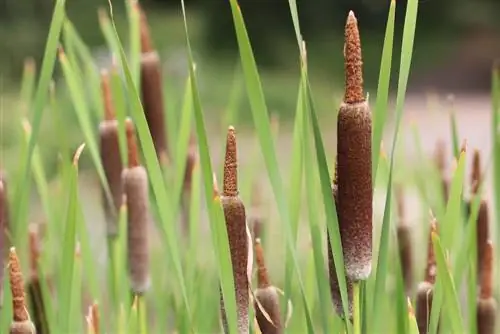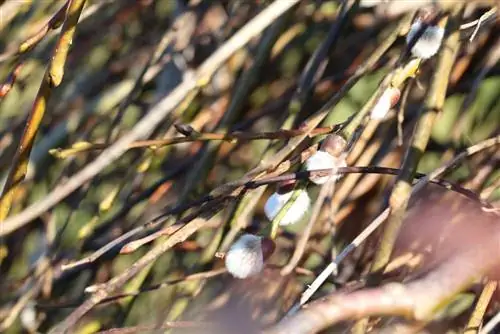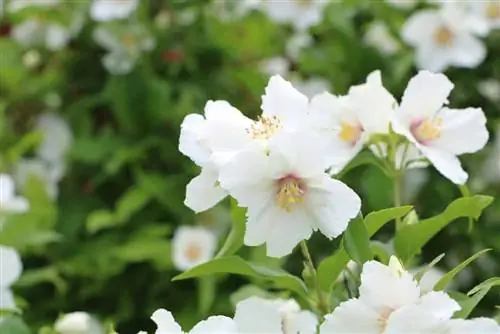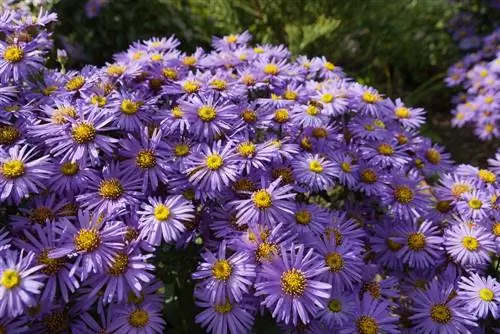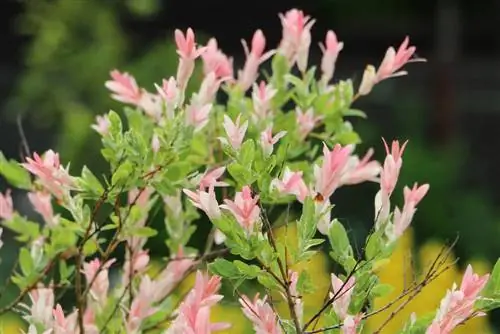- Author admin [email protected].
- Public 2023-12-17 03:39.
- Last modified 2025-01-24 12:45.
Cattails are a genus within the grass family that includes 16 to 40 species. They are distributed worldwide and occur in both temperate latitudes and tropical regions. Because of their striking leaf masses and decorative inflorescences, cattails are valued as ornamental grasses. They characterize moist habitats near water and form dense stands.
Popular species
Because of their water-purifying effect, cattails are valued by many pond owners. The plants make a valuable contribution to nature conservation in your own garden, as they offer smaller birds a protected habitat. Within the genus Typha there are several species that are often planted as ornamental grass.
- Laxmann's cattail (Typha laxmannii): up to 120 centimeters high
- Broad-leaved cattail (Typha latifolia): reaches heights of up to 200 centimeters
- Dwarf cattail (Typha minima): stays 40 centimeters low
- Narrow-leaved cattail (Typha angustifolia): up to 200 centimeters high
Tip:
The dwarf cattail is less problematic when it comes to growth. However, it places higher demands on the location.
Usage
The higher growing species are suitable for deeper water zones, while the dwarf cattail should not be planted deeper than 20 centimeters. Since all Typha species tend to overgrow, they should only be planted in sufficiently large bodies of water with a minimum area of seven to ten square meters. The better solution is a separate trench in which only cattails are planted. This also gives you excellent privacy protection. For more loosening up, other competitive reed plants or flowering plants with similar requirements can be planted between the cattails.
- Reed (Phragmites australis)
- Tall Cyprus grass (Cyperus longus)
- Yellow iris (Iris pseudacorus)
- Loosestrife (Lytrum salicaria)
- Watermint (Mentha aquatica)
Location and soil
Cattails have adapted to moist to wet locations. They grow in intermittently flooded areas that are often influenced by brackish water. Their natural habitats are along various bodies of water.
- moist edges of standing water
- muddy river banks
- Swamps and moors
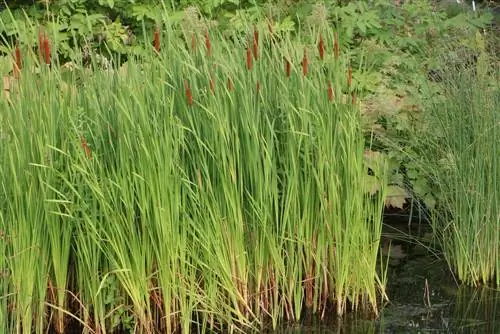
It is important to have nutrient-rich soil that does not dry out. Plant the cattail in boggy, loamy soil with a small amount of sand. The sweet grasses prefer full sun locations. They can be placed in a plant basket directly in low garden ponds or in the shallow water zone at the edge of the pond. The ideal water depth for the cattail is between 30 and 50 centimeters. Occasionally the rhizomes grow to depths of 100 centimeters. The pH value of the water should be in the medium-hard range between 8, 4 and 14.
Propagate
Bulrush can be propagated from seeds or by dividing the root tubers. Seed propagation requires some patience and is more complex than rhizome division.
Collect seeds yourself
Bulrushes lose their ability to germinate very quickly. The seeds must be sown within a few weeks of fruit ripening. Only absolutely fresh seeds germinate reliably, which is why specialist retailers rarely offer seeds. Watch the brown cobs regularly to wait for the right time. Fruit ripens between October and November. As soon as the cobs burst open and the cream-colored cotton balls become visible, it is time to harvest the seeds.
Sowing seeds directly
Immediately after collection, the seeds are sown. Use a substrate that has similar properties to a pond bottom. It should be nutrient-rich and preferably muddy. With cattails, you don't have to worry about soil permeability. The swamp plants have no problems with waterlogging and thrive in compacted soil with a high clay content.
- Sowing in late autumn or winter
- Germination occurs next spring
Recreate natural conditions
The grass, affectionately known as lamp cleaner, is also suitable for the pot. You can do this by growing the seeds indoors. Fill a shallow container with muddy soil and place the seeds about one to two centimeters deep in the substrate. The bowl is filled with lime-free water so that the substrate is wet.
- Store at 20 degrees Celsius for one to two weeks
- then refrigerate for four to six weeks
- A warm window seat is required for germination
This sequence mimics the natural weather conditions that occur in the wild. After the ripe seeds have been exposed to warm conditions on the partially shaded windowsill, they need a cold stimulus. The seeds are encouraged to germinate under frost-free conditions on the balcony or in the refrigerator. This is then done on the windowsill at mild temperatures.
Use vegetative propagation strategy
Cattail develops a strong rhizome that crawls through the substrate with the help of shoot sections shallowly below the soil surface. In this way, a swamp plant can develop an entire plant population. These are identical clones. In order to specifically propagate special cultivars, the rhizomes are divided and planted elsewhere. The ideal time for this measure is in spring, before the plants sprout again. Dig the rhizomes out of the substrate and separate the overgrown sections from the old rhizome. Cattails prove to be robust and resilient. You do not need to treat the interface additionally because it will grow over on its own within a short period of time.
Plants
Bulrushes are often sold in a planting basket, which is recommended for direct planting. The long rhizome runners can easily grow through the mesh of conventional mesh baskets, which is why you should replace the basket with a sturdy and impenetrable container. The strong roots can also pierce pond liner. There is space for up to three plants in one container. Eight to twelve plants of the larger specimens are sufficient per square meter to maintain a dense population. The plants grow together over time. If you want privacy protection more quickly, up to 16 units can be placed next to each other. For Typha angustifolia and Typha minima, two to four plants per square meter are sufficient.
Tip:
Place the cattail in a sturdy mortar tray filled with nutritious soil and sunk into the garden pond. You can create a mini reed bed with two to three tubs right next to each other.
Bucket
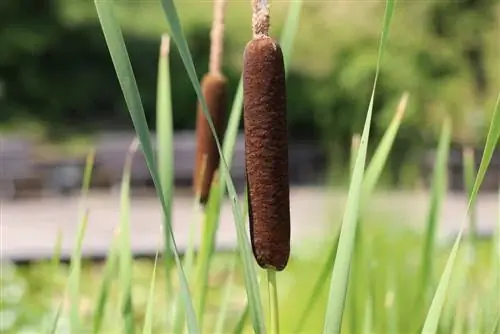
You can use the raw bulb to decorate a mini pond for a balcony or terrace if you don't have space for a pond in the garden. Get a frost-proof flower pot without a hole. A container made of plastic is ideal, as clay or stone can easily be cracked by frost if left outdoors over the winter. Fill the soil with a muddy substrate and place the cattail in the soil. Alternatively, you can use the grasses together with their plant baskets and weigh them down with stones.
Tip:
The mini pond gets some color if you plant water lilies. Plant the aquatic plants in April to enjoy the first blooms in summer.
Cutting
The cattail should be kept under constant observation because if left unobserved, it quickly takes over large areas. Targeted pruning measures at the right time of year therefore receive special attention.
Remove wilted leaf mass regularly
For the appearance, it is important that old plant parts are removed immediately. As soon as a stalk dries up, the cattail sprouts from the rhizome elsewhere. Dead shoot axes do not develop new shoots and can be cut off without hesitation. In smaller bodies of water, the leaf mass should also be trimmed continuously so that the cattail does not dominate the overall picture and rob weaker species of light.
Cutting cobs in summer
The lamp cleaner bulbs prove to be decorative elements in dried bouquets and arrangements. To do this, you have to cut off the inflorescence early. If the fruit is already ripening, the cobs can burst open at any time and release the hairy seeds. The cobs can be cut off at the beginning of the flowering period and then dried. By taking this measure, you prevent uncontrolled propagation by seeds that spread over long distances with the wind.
Tip:
Place the cobs in a warm and airy place to dry for two weeks. This means the stems remain stable for a long time.
Take a break from editing in the fall

Autumn is a busy time for gardeners with cattail beds, because the thick stalks of the sweet grasses remain standing over the winter. The dried-out stems with the tightly upright leaves provide relief in the gray garden during the cold and dreary season. You are also doing something to protect nature, as the hollow stems offer overwintering insects a protected place to retreat. The dried cobs are a popular food source for small songbirds, which feed on the leftover seeds in winter.
Carry out radical pruning in spring
It is only in spring that cattails are cut back to make room for fresh shoots. Grab several stems at their base and cut the bundle just above the ground. When taking this measure, you should also radically curb overgrown plants and shorten rhizomes, otherwise the stock will expand uncontrollably and displace other plants in the neighborhood.
Wintering
Cattails are hardy and survive the cold season without any problems as long as the substrate with the rhizomes does not freeze. If a layer of ice only forms on the surface of the water, there is no danger to the root nodules. If there are severe winter months ahead, you should, as a precaution, take the planters out of the shallow water zones and overwinter them in the cellar, free of frost. Otherwise, it is sufficient to tie the stalks together in autumn. This will prevent dead leaves from coming loose and sinking to the bottom of the water.
Diseases and pests
Species of the genus Typha prove to be robust. They are hardly affected by fungi, aphids or pathogens. Snails are not a problem either. The only danger comes from a type of moth. The owls (Nongaria) have largely specialized in plants. The great cattail owl, which lays its eggs on the leaves of the marsh plant, is widespread. Once the larvae hatch, they feed on the leaf mass until pupation. However, the moths do not appear in large numbers, so the cattail regenerates itself in nature. You don't have to expect an infestation in the garden.

